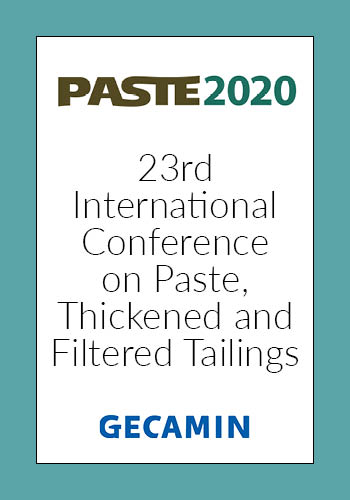Development of a new large calibration chamber for testing thickened tailings with the cone penetration test

|
Authors: Ayala, J; Fourie, A; Reid, D |
DOI https://doi.org/10.36487/ACG_repo/2052_51
Cite As:
Ayala, J, Fourie, A & Reid, D 2020, 'Development of a new large calibration chamber for testing thickened tailings with the cone penetration test', in H Quelopana (ed.), Paste 2020: 23rd International Conference on Paste, Thickened and Filtered Tailings, Gecamin Publications, Santiago, https://doi.org/10.36487/ACG_repo/2052_51
Abstract:
New tailings storage technologies come with new geotechnical characterisation challenges. Additional to the already difficult task of assessing the stability of tailings dams is the frequent requirement of measuring the time-dependent behaviour of tailings. Such time-dependent tailings responses can be monitored using piezometers, which provide continuous data of the pore water pressure within the dam. However, this frequent monitoring must be complemented by in situ investigations. For such in situ testing, the cone penetration test is recommended, mainly because of the useful data that it provides to practitioners, the worldwide availability of suitable equipment, and the rich database of correlations and interpretations available. For the development of these widely used correlations, different techniques have been used in the past including theoretical, numerical and experimental approaches. Since the first two techniques correspond to approximations, experimental data is preferred. These experimental data are usefully derived from calibration chamber testing, which has provided valuable contributions. Since paste and thickened tailings do not generally segregate after deposition, there is an increasing need for developing correlations for cone penetration testing in such materials, which invariably have substantial fines contents. A variety of different calibration chambers have been used for many decades, mainly to create correlations between known soil density, effective stress and saturation conditions. This work presents the development of a new large calibration chamber at the University of Western Australia, the design of which is based on other currently available calibration chambers, but with added capabilities identified as necessary from laboratory characterisation experience of mine tailings within the critical state soil mechanics framework. These include enabling improved tracking of volume changes during saturation and consolidation, as this aspect requires special attention for many thickened tailings materials.
References:
BOLTON, M. D., GUI, M. W., GARNIER, J., CORTE, J. F., BAGGE, G., LAUE, J. & RENZI, R. 1999. Centrifuge cone penetration tests in sand. Géotechnique, 49, 543-552.
DAMAVANDI-MONFARED, S. & SADREKARIMI, A. 2015. Development of a Miniature Cone Penetrometer for Calibration Chamber Testing. Geotechnical Testing Journal, 38, 878-892.
FOURIE, A. B. & PAPAGEORGIOU, G. 2001. Defining an appropriate steady state line for Merriespruit gold tailings. Canadian Geotechnical Journal, 38, 695-706.
FOURIE, A. B. & TSHABALALA, L. 2005. Initiation of static liquefaction and the role of K0 consolidation. Canadian Geotechnical Journal, 42, 892-906.
GHIONNA, V. N. & JAMIOLKOWSKI, J. H. A critical appraisal of calibration chamber testing of sands. In: HUANG, A.-B., BORDEN, R. H., PETERSON, R. W. & THMAY, M. T., eds. Proceedings of the First International Symposium on Calibration Chamber Testing, 1991 New York. Elsevier, 13-39.
GUI, M. & BOLTON, M. Geometry and scale effects in CPT and pile design. In: MAYNE, E. B. P. R. A. P., ed. Geotechnical site characterization., 1998 Balkema, Rotterdam. 1063-1068.
GUI, M., BOLTON, M., GARNIER, J., CORTE, J., BAGGE, G., LAUE, J. & RENZI, R. Guidelines for cone penetration tests in sand. Proceedings of the International Conference Centrifuge 98, 1998 Tokyo, Japan. 155-160.
ISHIHARA, K. 1993. Liquefaction and flow failure during earthquakes. Géotechnique, 43, 351-451.
JEFFERIES, M. & BEEN, K. 2000. Implications for critical state theory from isotropic compression of sand. Géotechnique, 50, 419-429.
JEFFERIES, M. G. & BEEN, K. 2015. Soil Liquefaction: A Critical State Approach, Boca Raton, FL, CRC Press.
LADD, R. 1978. Preparing Test Specimens Using Undercompaction. Geotechnical Testing Journal, 1, 16-23.
POURNAGHIAZAR, M., RUSSELL, A. & NASSE, K. 2011. Development of a new calibration chamber for conducting cone penetration tests in unsaturated soils. Canadian Geotechnical Journal, 48, 314-321.
POURNAGHIAZAR, M., RUSSELL, A. R. & KHALILI, N. 2012. Linking cone penetration resistances measured in calibration chambers and the field. Géotechnique Letters, 2, 29-35.
SALGADO, R., MITCHELL, J. K. & JAMIOLKOWSKI, M. 2001. Calibration Chamber Size Effects on Penetration Resistance in Sand.
SWEENEY, B. & CLOUGH, G. 1990. Design of a Large Calibration Chamber. Geotechnical Testing Journal, 13, 36-44.
VERDUGO, R. & ISHIHARA, K. 1996. The steady state of sandy soils. Soils and Foundations, 36, 81-91.
WESLEY, L. D. 2002. Interpretation of calibration chamber tests involving cone penetrometers in sands. Géotechnique, 52, 289-293.
YANG, H. & RUSSELL, A. R. 2015. Cone penetration tests in unsaturated silty sands. Canadian Geotechnical Journal, 53, 431-444.
© Copyright 2025, Australian Centre for Geomechanics (ACG), The University of Western Australia. All rights reserved.
View copyright/legal information
Please direct any queries or error reports to repository-acg@uwa.edu.au
View copyright/legal information
Please direct any queries or error reports to repository-acg@uwa.edu.au